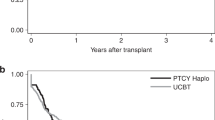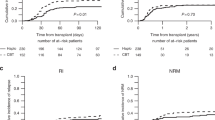Abstract
Over the past decade, relevant improvements and refinements have significantly changed the indications, technique and results obtained with allogeneic hematopoietic SCT (HSCT) in childhood. A fundamental turning point in the history of allogeneic HSCT is represented by the use of placental blood, which was first employed in 1988 in a patient with Fanconi anemia, successfully transplanted with cord blood cells from an HLA-identical sibling. Since then, thousands of children were given an allograft of cord blood-derived hematopoietic progenitors, mainly from an unrelated donor. This large clinical experience has documented that, as compared with BMT, cord blood transplantation (CBT) is associated with reduced incidence and severity of GvHD. The outcome of recipients given unrelated CBT has been reported to be at least as good as that of patients transplanted with either BM or peripheral blood mobilized cells of an unrelated volunteer. Another emerging strategy of HSCT is that of using HLA-partially matched relatives as donors of hematopoietic progenitors. The infusion of a huge number of positively in vitro-selected CD34+ cells, with the concomitant removal of T cells, has been demonstrated to permit sustained engraftment of donor hematopoiesis, without the occurrence of GvHD in the majority of patients transplanted from an HLA-disparate relative. In adults given this type of transplantation, the most favorable results have been reported for AMLs and when the donor displays alloreactivity of natural killer cells. It remains to be definitively proved whether these findings documented in adults maintain their value in pediatric patients transplanted from an HLA-disparate family donor. Finally, the last few years have witnessed the emergence of approaches of adoptive cell therapy aimed at optimizing the results of allograft through strategies able to reinforce immune competence against pathogens, as well as against tumor cells, or at modulating donor T-cell alloreactivity.
This is a preview of subscription content, access via your institution
Access options
Subscribe to this journal
Receive 12 print issues and online access
$259.00 per year
only $21.58 per issue
Buy this article
- Purchase on Springer Link
- Instant access to full article PDF
Prices may be subject to local taxes which are calculated during checkout
Similar content being viewed by others
References
Locatelli F, Burgio GR . Transplant of haematopoietic stem cells in childhood: where we are and where we are going. Haematologica 1998; 83: 550–563.
Gatti RA, Meuwissen HJ, Allen HD, Hong R, Good RA . Immunological reconstitution of sex linked lymphopenic immunological deficiency. Lancet 1968; 2: 1366–1369.
Bach FM, Albertini MJ, Joho P, Anderson JL, Bortin MM . Bone marrow transplantation in a patient with the Wiskott-Aldrich syndrome. Lancet 1968; 2: 1364–1366.
Gluckman E, Broxmeyer HA, Auerbach AD, Friedman HS, Douglas GW, Devergie A et al. Hematopoietic reconstitution of a patient with Fanconi's anemia by means of umbilical cord blood from an HLA identical sibling. N Engl J Med 1989; 32: 1174–1178.
Bertolini F, Battaglia M, De Iulio C, Sirchia G . Placental blood collection: effects on newborns. Blood 1995; 85: 3361–3362.
Locatelli F, Rocha V, Reed W, Bernaudin F, Ertem M, Grafakos S et al. Related umbilical cord blood transplantation in patients with thalassemia and sickle cell disease. Blood 2003; 101: 2137–2143.
Rubinstein P, Carrier C, Scaradavou A, Kurtzberg J, Adamson J, Migliaccio AR et al. Outcomes among 562 recipients of placental blood transplants from unrelated donor. N Engl J Med 1998; 339: 1565–1577.
Rocha V, Cornish J, Sievers EL . Comparison of outcomes of unrelated bone marrow and umbilical cord blood transplants in children with acute leukemia. Blood 2001; 97: 2962–2971.
Eapen M, Rubinstein P, Zhang M, Stevens C, Kurtzberg J, Scaradavou A et al. Outcomes of transplantation of unrelated donor umbilical cord blood and bone marrow in children with acute leukemia: a comparison study. Lancet 2007; 369: 1947–1954.
Rocha V, Wagner Jr JE, Sobocinski KA, Klein JP, Zhang MJ, Horowitz MM et al. Graft-versus-host disease in children who have received a cord-blood or bone marrow transplant from an HLA-identical sibling. Eurocord and International Bone Marrow Transplant Registry Working Committee on Alternative Donor and Stem Cell Sources. N Engl J Med 2000; 342: 1846–1854.
Gluckman E, Rocha V, Arcese W, Michel G, Sanz G, Chan KW, et al., on behalf of the Eurocord Group. Factors associated with outcomes of unrelated cord blood transplant: Guidelines for donor choice. Exp Hematol 2004; 32: 397–407.
Michel G, Rocha V, Chevret S, Arcese W, Chan KW, Filipovich A et al. Unrelated cord blood transplantation for childhood acute myeloid leukemia: a Eurocord Group analysis. Blood 2003; 102: 4290–4297.
Grewal SS, Barker JN, Davies SM, Wagner JE . Unrelated donor hematopoietic cell transplantation: marrow or umbilical cord blood? Blood 2003; 101: 4233–4244.
Kernan NA, Bartsch G, Ash RC, Beatty PG, Champlin R, Filipovich A et al. Analysis of 462 transplantations from unrelated donors facilitated by the National Marrow Donor Program. N Engl J Med 1993; 328: 593–602.
Davies SM, Wagner JE, Shu XO, Blazar BR, Katsanis E, Orchard PJ et al. Unrelated donor bone marrow transplantation for children with acute leukemia. J Clin Oncol 1997; 15: 557–565.
Petersdorf EW, Gooley TA, Anasetti C, Martin PJ, Smith AG, Mickelson EM et al. Optimizing outcome after unrelated marrow transplantation by comprehensive matching of HLA class I and II alleles in the donor and recipient. Blood 1998; 92: 3515–3520.
Giebel S, Giorgiani G, Martinetti M, Zecca M, Maccario R, Salvaneschi L et al. Low incidence of severe acute graft-versus-host disease in children given haematopoietic stem cell transplantation from unrelated donors prospectively matched for HLA class I and II alleles with high-resolution molecular typing. Bone Marrow Transplant 2003; 31: 987–994.
La Nasa G, Giardini G, Argiolu F, Locatelli F, Arras M, De Stefano P et al. Unrelated donor bone marrow transplantation for thalassemia: the effect of extended haplotypes. Blood 2002; 99: 4350–4356.
Locatelli F, Nöllke P, Zecca M, Korthof E, Lanino E, Peters C et al. Hematopoietic stem cell transplantation (HSCT) in children with juvenile myelomoncytic leukemia (JMML): results of the EWOG-MDS/EBMT trial. Blood 2005; 105: 410–419.
Saarinen-Pihkala UM, Gustafsson G, Ringden O, Heilmann C, Glomstein A, Lönnerholm G et al. No disadvantages in outcome of using matched unrelated donors as compared with matched sibling donors as compared with matched sibling donors for bone marrow transplantation in children with acute lymphoblastic leukemia in second remission. J Clin Oncol 2001; 19: 3406–3414.
Aversa F, Tabilio A, Velardi A, Cunningham I, Terenzi A, Falzetti F et al. Treatment of high risk acute leukaemia with T-depleted stem cells from related donors with one fully mismatched HLA haplotype. N Eng J Med 1998; 339: 1186–1193.
Aversa F, Terenzi A, Tabilio A, Falzetti F, Carotti A, Ballanti S et al. Full haplotype-mismatched hematopoietic stem-cell transplantation: a phase II study in patients with acute leukaemia at high risk of relapse. J Clin Oncol 2005; 23: 3447–3454.
Ruggeri L, Capanni M, Urbani E, Perruccio K, Shlomchik WD, Tosti A et al. Effectiveness of donor natural killer cell alloreactivity in mismatched hematopoietic transplants. Science 2002; 295: 2097–2100.
Velardi A, Ruggeri L, Moretta A, Moretta L . NK cells: a lesson from mismatched hematopoietic transplantation. Trends Immunol 2002; 23: 438–444.
Locatelli F, Comoli P, Montagna D, Rossi F, Daudt L, Maccario R . Innovative approaches of adoptive immune cell therapy in paediatric recipients of haematopoietic stem cell transplantation. Best Pract Res Clin Haematol 2004; 17: 479–492.
Perruccio K, Tosti A, Burchielli E, Topini F, Ruggeri L, Carotti A et al. Transferring functional immune responses to pathogens after haploidentical hematopoietic transplantation. Blood 2005; 106: 4397–4406.
Heslop EE, Rooney CM . Adoptive cellular immunotherapy for EBV lymphoproliferative diseases. Immunol Rev 1997; 157: 217–222.
Comoli P, Basso S, Zecca M, Pagliara D, Baldanti F, Bernardo ME et al. Pre-emptive treatment of EBV-related post-transplant lymphoproliferative disorders in pediatric recipients of haploidentical, T-cell depleted hematopoietic stem cell transplantation. Am J Transplant 2007; 7: 1648–1655.
Einsele H, Roosnek E, Rufer N, Sinzger C, Riegler S, Löffler J et al. Infusion of cytomegalovirus (CMV)-specific T cells for the treatment of CMV infection not responding to antiviralchemotherapy. Blood 2002; 99: 3916–3922.
Pittenger MF, Mackay AM, Beck SC, Jaiswal RK, Douglas R, Mosca JD et al. Multilineage potential of adult human mesenchymal stem cells. Science 1999; 284: 143–147.
Aggarwal S, Pittinger MF . Human mesenchymal stem cells modulate alloantigen immune cell responses. Blood 2005; 105: 1815–1822.
Locatelli F, Maccario R, Frassoni F . Mesenchymal stromal cells, from indifferent spectators to principal actors. Are we going to witness a revolution in the scenario of allograft and immune-mediated disorders? Haematologica 2007; 92: 872–877.
Maccario R, Podestà M, Moretta A, Cometa A, Comoli P, Montagna D et al. Interaction of human mesenchymal stem cells with cells involved in alloantigen-specific immune response favors the differentiation of CD4+ T-cell subsets expressing a regulatory/suppressive phenotype. Haematologica 2005; 90: 516–525.
Uccelli A, Pistoia V, Moretta L . Mesenchymal stem cells: a new strategy for immunosuppression? Trends Immunol 2007; 28: 219–226.
Maccario R, Moretta A, Cometa A, Podestà M, Montagna D, Comoli P et al. Human mesenchymal stem cells and Cyclosporin-A exert a synergistic suppressive effect on in vitro activation of alloantigen-specific cytotoxic lymphocytes. Biol Blood Marrow Transplant 2005; 11: 1031–1032.
Bartholomew A, Sturgeon C, Siatskas M, Ferrer K, McIntosh K, Patil S et al. Mesenchymal stem cells suppress lymphocyte proliferation in vitro and prolong skin graft survival in vivo. Exp Hematol 2002; 30: 42–48.
Le Blanc K, Rasmusson I, Sundberg B, Götherström C, Hassan M, Uzunel M et al. Treatment of severe graft-versus-host disease with third party haploidentical mesenchymal stem cells. Lancet 2004; 363: 1439–1441.
Ringden O, Uzunel M, Rasmusson I, Remberger M, Sundberg B, Lönnies H et al. Mesenchymal stem cells for treatment of therapy-resistant graft-versus-host disease. Transplantation 2006; 81: 1390–1397.
Le Blanc K, Frassoni F, Ball L, Locatelli F, Lewis I, Lanino E et al. Mesenchymal stem cells for treatment of severe acute graft-versus-host disease. Blood 2006; 108 (Suppl 1): 226a.
Acknowledgements
This work was partially supported by grants from AIRC (Associazione Italiana Ricerca sul Cancro), CNR (Consiglio Nazionale delle Ricerche), MURST (Ministero dell’Università e della Ricerca Scientifica e Tecnologica), European Union (FP6 program ALLOSTEM) and Fondazione IRCCS Policlinico San Matteo to FL.
Author information
Authors and Affiliations
Corresponding author
Additional information
Conflict of interest
None of the authors declared any financial interests.
Rights and permissions
About this article
Cite this article
Locatelli, F., Giorgiani, G., Di-Cesare-Merlone, A. et al. The changing role of stem cell transplantation in childhood. Bone Marrow Transplant 41 (Suppl 2), S3–S7 (2008). https://doi.org/10.1038/bmt.2008.45
Published:
Issue Date:
DOI: https://doi.org/10.1038/bmt.2008.45
Keywords
This article is cited by
-
T Cell Immunotherapy for Immune Reconstitution and GVHD Prevention After Allogeneic Hematopoietic Stem Cell Transplantation
Current Stem Cell Reports (2015)
-
Taste and smell function in pediatric blood and marrow transplant patients
Supportive Care in Cancer (2012)
-
Co-infusion of ex vivo-expanded, parental MSCs prevents life-threatening acute GVHD, but does not reduce the risk of graft failure in pediatric patients undergoing allogeneic umbilical cord blood transplantation
Bone Marrow Transplantation (2011)
-
The EBMT Paediatric Diseases Working Party: current concepts and future aims
memo - Magazine of European Medical Oncology (2009)



